Chapter 2.
IMPERATOR ANDRONICUS KOMNIN OF THE XII CENTURY - IT IS JESUS CHRIST DURING HIS PRESENCE IN TSAR-GRAD OF THE XII CENTURY.
28. ISSAC (ISAAKIOS) ANGELOS WHO REBELLED AGAINST ANDRONICUS AND SATAN, THE SUPREME ANGEL, WHO REBELLED AGAINST GOD.
28.1. ISAAC (ISAAKIOS) ANGELOS AS SATAN.
A distinct imprint in the turbulent events under Andronicus-Christ also shows through in the Christian teaching on angels. In fact we saw that one of the Angels, namely Isaac Angelos eventually betrayed him and became a king himself, see above [140], p.349-354. The Christian Theology states that the Supreme Angel under the name of Sataniel rebelled against God and wished to become his equal. I.e. rose up against God. Thus Satan or the Fallen Angel emerged. We can see a clear analogy here between Isaac Angelos and Satan. Below, when we discuss the Egyptian events, we will see for ourselves that this analogy is far from accidental, and the name of Satan in one of its forms was in fact the name of Isaac Angelos.
This topic turns out to be so interesting and important, that we shall look at it in more detail.
28.2. THE CHRISTIAN TEACHING ABOUT SATAN.
We will briefly touch upon the Christian teaching about Satan, see for example ‘The Larger Catechism’ [23].
When God created the world the Angels served him. Sataniel or Sata or Shaitan (S turns into Sh) was the chief Angel. Shaitan was filled with pride and wished to become equal to God. He led some Angels away with him. In other words he stirred mutiny amongst the Angels against God. The army of the Angels defending God was led by Archangel Michael. There was a battle between Satan’s rebellious Angels and the Angels who remained faithful to God. Archangel Michael won, see fig. 2.44 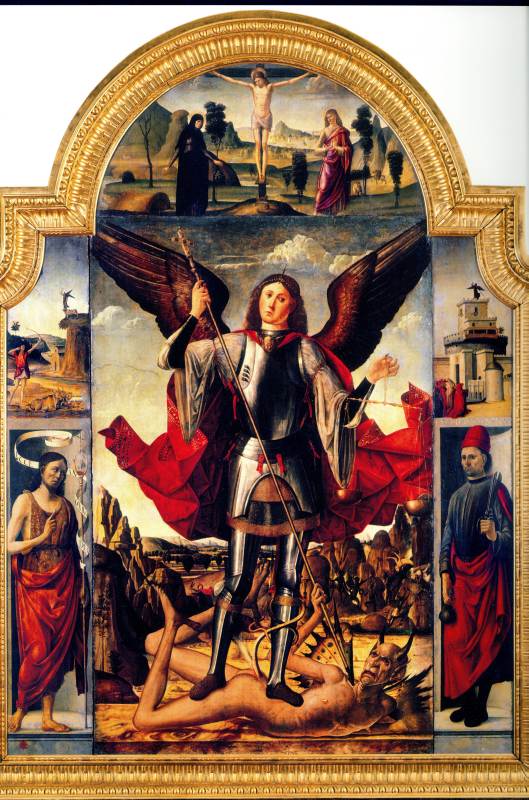 and fig.2.45
and fig.2.45  . Satan together with his followers was cast down and ‘chained’, see fig.2.46
. Satan together with his followers was cast down and ‘chained’, see fig.2.46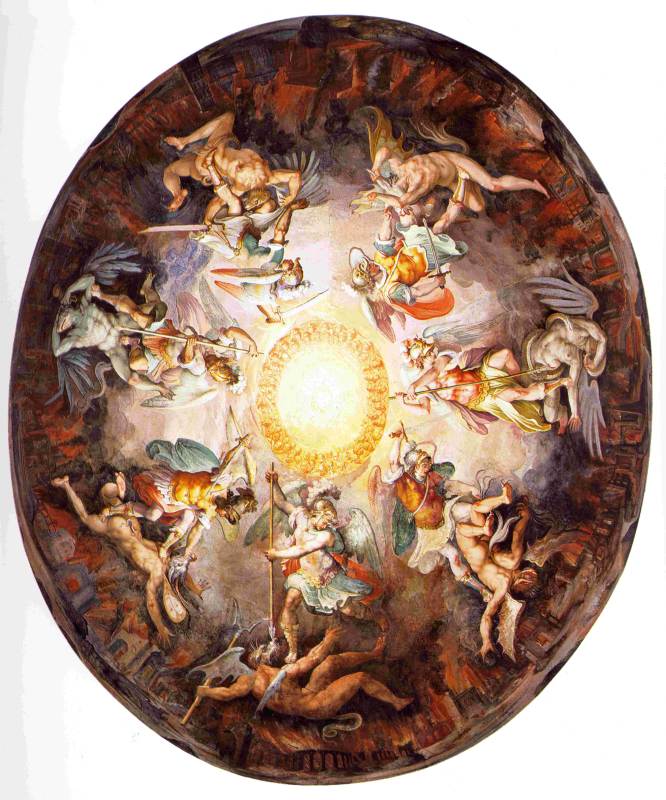 . It is said that before the end of the world Satan will cast off his chains and will rule the world until the second coming of Christ.
. It is said that before the end of the world Satan will cast off his chains and will rule the world until the second coming of Christ.
[105], p.139.
‘SATAN … this name refers to the fallen spirits… Beelzebub the chief of the devils (Luke 11:15), Belail (2 Corinthians 6:15), the prince of this world (John 12:31) … The church teaching on the evil spirits … recognises the evil spirit … as originally a good angel … fallen from God… Only Origen and some other few contrary to popular belief accepted the possibility of conversion and forgiveness … The Mediaeval scientists did not fall behind the common superstition and created rather complex and monstrous theories about the evil spirits’ [153].
Today this teaching is considered to be purely metaphysical. In other words it is believed that no earthly events lie at its root. That it is a purely spiritual struggle between the light and dark forces.
However we begin to understand that at the basis of this teaching there were still quite real events of the late XII century. It is likely that the rebellion of the fallen angel Satan against God is the revolt of Isaac Angelos against Andronicus-Christ in 1185. I.e. the mutiny against God.
In the Mediaeval Christian works of Bogomils it states that Satan was a brother of Jesus Christ. We cite: ’The Mediaeval Bogomils … spoke of Sataniel (Satan + ‘el, ‘God’) as a son of God and a brother of Jesus Christ…Irenaeus of Lyon, the early Christian writer of the 2nd century, recorded a legend according to which Satan and the demons reached the full measure of rage and desperation exactly as a result of Christ’s coming, ministry, sacrificial death and resurrection … Since then Satan is evidently ‘damned’… for the time being remaining the ‘prince of this world’… Origen of the 2-3 cc. taught that in the end of times all the creatures who fell apart from God, including Satan, will be converted and will be saved … but this doctrine by Origen did not receive the recognition … In Dante’s ‘Divine Comedy’ … teeth of his (Satan’s – Author) mouths torture Judas Iscariot, the betrayer of the highest spiritual authority, and Brutus, and Cassius – the rebels, who encroached upon the highest public authority’ [95], v.2, p.413.
Hence, it is apparent, that originally according to the Christian authors, Satan was closely associated with Christ, see fig.2.47 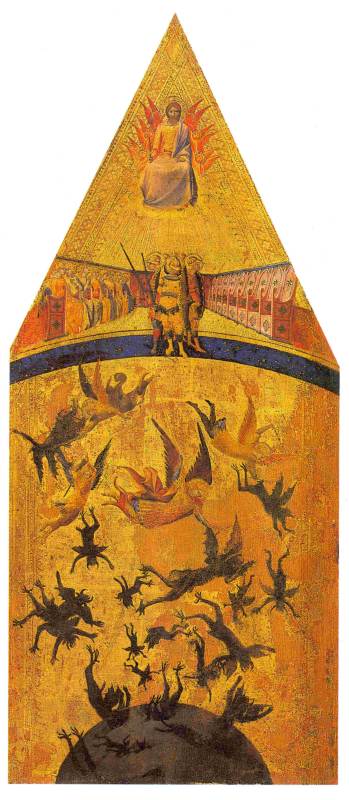 and fig. 2.48
and fig. 2.48 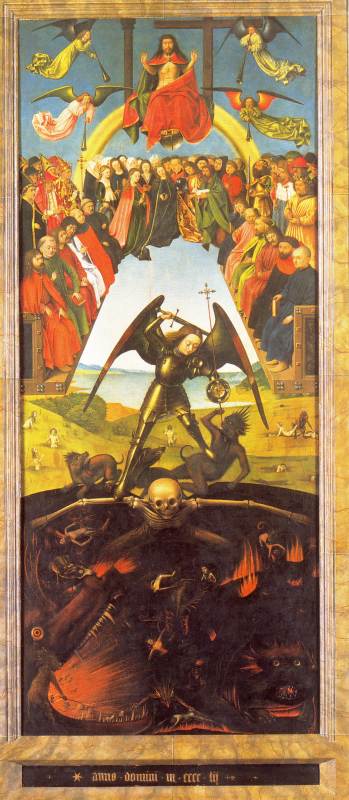 . Moreover, some of the few old depictions of Satan cast down by Archangel Michael were directly presented as the punishment for Christ’s execution, see for example fig.2.49
. Moreover, some of the few old depictions of Satan cast down by Archangel Michael were directly presented as the punishment for Christ’s execution, see for example fig.2.49 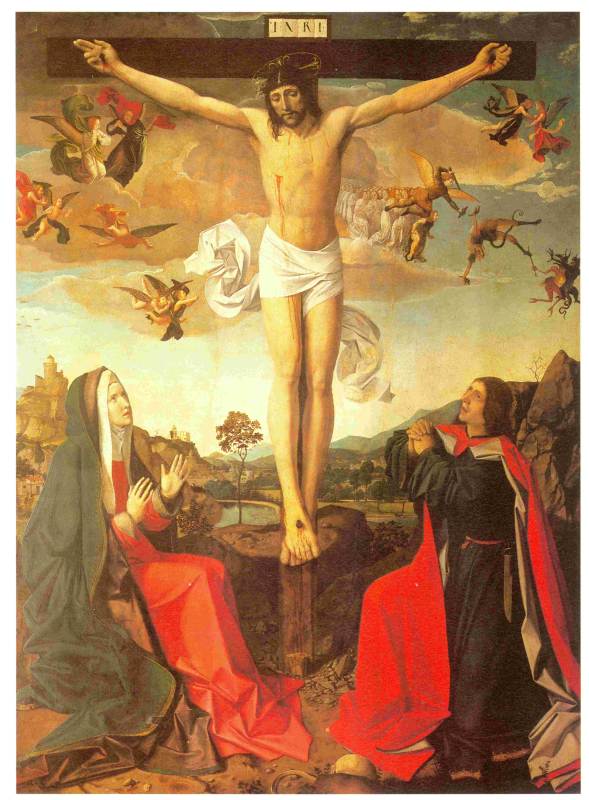 . But then when over time the true events were forgotten, the recollections of the rebellion of Satan – Isaac against Christ-Andronicus became incomprehensible and were called heretical. They were rejected.
. But then when over time the true events were forgotten, the recollections of the rebellion of Satan – Isaac against Christ-Andronicus became incomprehensible and were called heretical. They were rejected.
28.3. THE BROTHERS OF CHRIST.
When comparing the references to Satan with the story of Andronicus we see a fine match. Indeed, Isaac Angelos was Andronicus’ relative, as the families of the Angels and the Komnenoi were related, see the genealogical tables in [140]. I.e. in some way he was his ‘brother’ though not his biological brother. In general, Nicetas Choniates stresses, that the resentment over Andronicus was growing, including amongst his relatives, who were unhappy with the emperor not presenting them with those benefits, which they were expecting as the members of his family clan, see above. The same notion is also expressed in the Gospel of John. He writes directly: ‘For neither did his brethren believe in him’ (John 7:5). And also: ‘Your own clan and your chief priests handed you over to me’ says Pilates to Jesus [127], p.187 reverse side. Moreover, in fact John accuses Jesus’ brothers of attempting to convince him to risk mortal danger and come to Jerusalem when the Jews sought to kill him. Jesus refused to. John (7:1-6).
Thus, Isaac’s (Satan’s) uprising against Andronicus was the uprising of a brother. We should note that the word ‘brother’ was used to call not just the blood brothers, but the relatives in general on the same branch of the family tree. For example, cousins, second cousins and third cousins were referred to simply as a ‘brother’. In this regard our attention is drawn to the fact that Dante in his ‘The Divine Comedy’ places Brutus and Cassius, the murderers of the Sun Czar = Julius Caesar in Satan’s mouths together with Judas Iscariot. We shall clarify that JULIUS or HELIOS – the Sun and Caesar is the same as Czar. But then it occurs to us that BRUTUS in this instance means simply BROTHER, and CASSIUS when read backwards is the name ISAAC. That is why the infamous story of the murder of Julius Caesar (the Sun Czar) by Brutus and Cassius (by Brother Isaac) most likely is the reflection of the Gospel story about the execution of Andronicus-Christ by his relative Isaac Angelos. The event which took place in the very beginning of the history of Christianity was so significant, that later on, when the Christians came to power it ‘spread’ into many chronicles and today we come across it in the different variations and reflections.
28.4. THE TEMPTATION OF CHRIST BY THE DEVIL ON THE TEMPLE’S SUMMIT.
In the book by Robert de Clari ‘The Conquest of Constantinople’ a lot of time is devoted to Andronicus. Robert de Clari describes in detail the revolt of Isaac Angelos reporting on the interesting points missing in the other sources. He writes the following in particular: ‘When Kirsac (i.e. the czar, kir (king) Isaac - Author) was crowned, the news of it spread everywhere. Thus Androm also learnt of it and that he had murdered his bailie (i.e. Stephen Hagiochristophorites – Author); and he could not believe it until he summoned his spies… When the emperor found out he got up, took many of his men with him and went to the church of Hagia Sophia via a passage which led him directly to the temple. When he got to the temple he managed to get to GALLERY UNDER THE TEMPLE VAULTS unnoticed and saw the one who was crowned. When he saw him, he was very saddened by it and asked his people if anyone had a bow and they brought him a bow and arrows. Androm took the bow and braced it aiming to strike him straight to the heart, but at the very moment when he was taking aim the bow-string broke, he was stunned by that and having felt abashed he fell into despair; and he returned back to his palace’ [17], p.21.
What is this referring to? Andronicus enters the portico under the very roof of Hagia Sophia and sees below emperor Isaac Angelos who has already being crowned. Andronicus wants to shoot him down with his bow. But for some reason he does not do it. According to Robert de Clari it is not due to the fact that his bow-string has broken. Andronicus is very distressed and leaves without attempting it again.
A question arises – is there anything similar in the Gospels? Yes, there is, and in a dramatic way. Matthew and Luke say the following. Christ was tempted by Satan. Where in particular Satan '… brought him to Jerusalem, and set him on a pinnacle of the temple, and said unto him, If thou be the Son of God, cast thyself down from hence: For it is written, He shall give his angels charge over thee, to keep thee: And in their hands they shall bear thee up, lest at any time thou dash thy foot against a stone. And Jesus answering said unto him, It is said, Thou shalt not tempt the Lord thy God. And when the devil had ended all the temptation, he departed from him for a season. And Jesus returned in the power of the Spirit into Galilee: and there went out a fame of him through all the region round about’ (Luke 4:9-14). See also (Matthew 4:5-7).
Matthew adds the following: ‘Again, the devil taketh him up into an EXEEDING HIGH MOUNTAIN, and sheweth him all the kingdoms of the world, and the glory of them; And saith unto him, All these things will I give thee, if thou wilt FALL DOWN AND WORSHIP ME. Then saith Jesus unto him, Get thee hence, Satan: for it is written, Thou shalt worship the Lord thy God, and him only shalt thou serve’ (Matthew 4:8-10).
Now we understand that under the name of Satan here could be presented Isaac Angelos uprising against Andronicus-Christ and who became the emperor that night. Added too, that Robert de Clari reports, that Andronicus saw Isaac Angelos as a new king, when standing at a gallery under the dome of the temple. Therefore the Gospel story presented above acquires an entirely different and transparent meaning.
Taking Christ to the temple wing by Satan is the compelled arrival of Andronicus to Czar-Grad. From there, from above he sees Isaac Angelos – the new king. There was probably some kind of a conversation between them that took place. And THE GOSPELS CONVEY THIS CONVERSATION IN DETAIL AS A CONVERSATION BETWEEN CHRIST AND SATAN. It tells us how Satan – Isaac offers Christ-Andronicus important positions in exchange for him accepting defeat and that he will bow unto him. Christ-Andronicus refuses and leaves. In the old image we see representation of this scene, fig.2.50 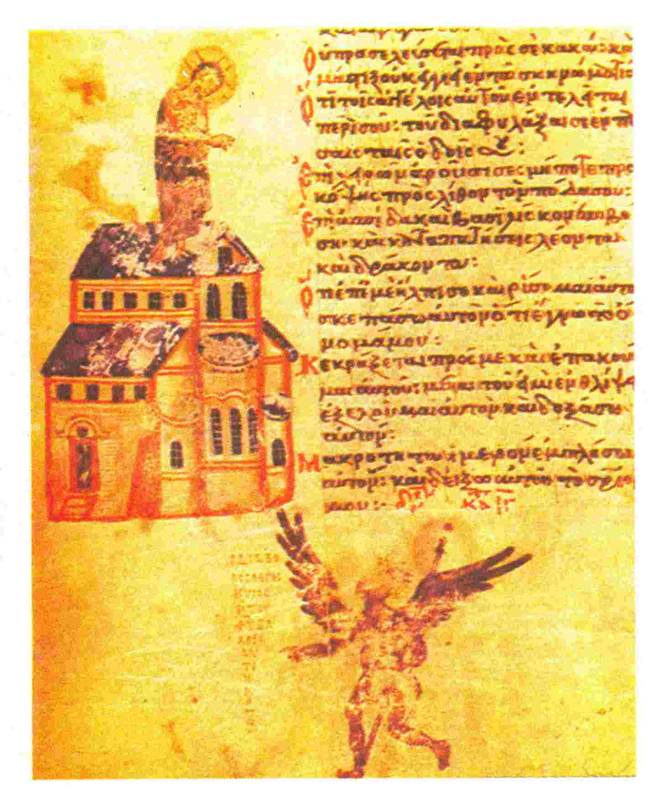 . Christ is standing on the rooftop of the temple and Satan is standing in the square below. They are talking.
. Christ is standing on the rooftop of the temple and Satan is standing in the square below. They are talking.
Besides, the Gospels tell us about the inner temptation of Andronicus–Christ at that moment. But due to some reasons he abandons his original intention. Possibly, understanding its absurdity. Unless the bow-string did really break. It is difficult to say now. This is the Gospel’s temptation of Christ by the devil - Satan.
The fig.2.51 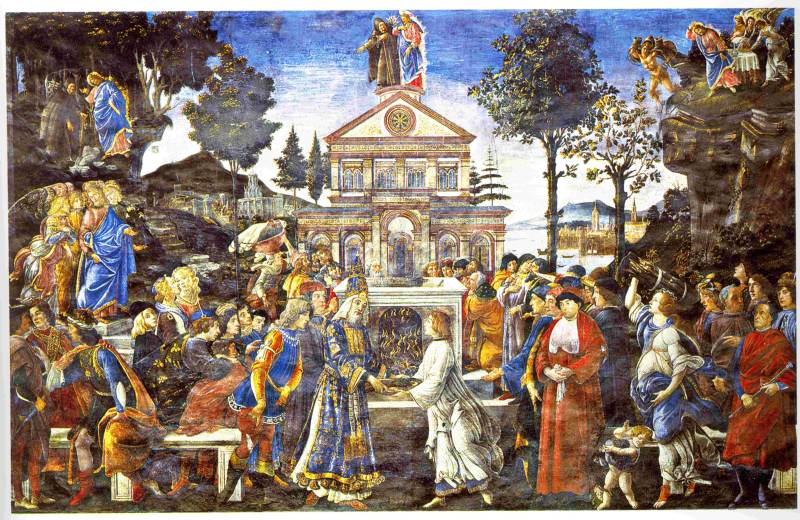 presents the painting by Botticelli ‘Scenes from the life of Christ: The Temptation of Christ; Jesus cleansing a leper’. In the very center there stands Christ tempted by Satan. Curiously, Satan is represented here as a normal person, see fig. 2.52
presents the painting by Botticelli ‘Scenes from the life of Christ: The Temptation of Christ; Jesus cleansing a leper’. In the very center there stands Christ tempted by Satan. Curiously, Satan is represented here as a normal person, see fig. 2.52 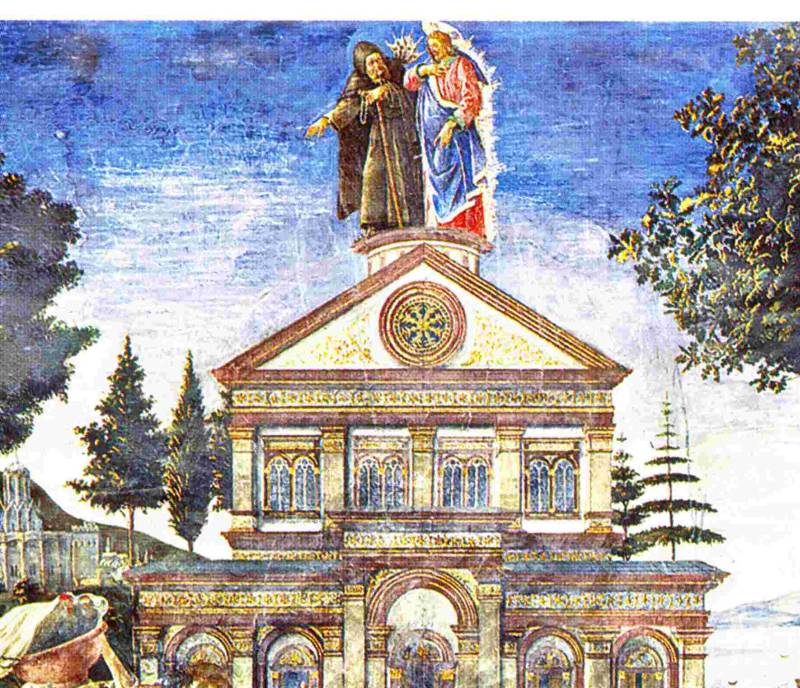 , and not in a fantastical-fairytale way (horns, hoofs, etc). He is dressed in the monk’s clothing holding a staff. It is probable, that in the times of Botticelli they still remembered (though vaguely), that the Gospels gives a description of a conversation between Isaac Angelos and Andronicus.
, and not in a fantastical-fairytale way (horns, hoofs, etc). He is dressed in the monk’s clothing holding a staff. It is probable, that in the times of Botticelli they still remembered (though vaguely), that the Gospels gives a description of a conversation between Isaac Angelos and Andronicus.
By the way, in regards to the word ‘devil’. It consists of two parts: DE-VIL, i.e. GOD (DEITY )- BULL or GOD – Ox. (in Russian ‘DIAVOL’ is DEVIL: ‘DIA’ (GOD) ‘VOL’ (BULL). We would like to remind you that ‘DIA’ means God, and ‘VOL’ is a bull. Such a name befits Isaac Angelos quite well. The fact is, that according to Nicetas Choniates, he considered himself a ‘bovine emperor’. We quote: ‘Isaakios Angelos … played the role of the righteous man most masterfully …CONTINUING THE VERSES which were said OF THE BOVINE EMPEROR and mistakenly APPLYING THEM TO HIMSELF’ [141], p.5. Thus he called himself King-bull, which could have been passed on as DIA-VOL (DE-VIL), GOD-BULL.
28.5. THE BOW OF CHRIST-ANDRONICUS.
In the accounts of Nicetas Choniates, Robert de Clari and other authors describing the fall of Andronicus, a lot of attention is paid to the fact, that during the uprising Andronicus was personally shooting from a bow. We have already cited Robert de Clari above: ‘When he (Andronicus – Author) saw him (Isaac Angelos – Author), he was very saddened by it and asked his people if anyone had a bow and they brought him a bow and arrows. Androm took the bow and braced it aiming to strike Kirsac (i.e. Isaac – Author), who was crowned, straight in the heart. But at the very moment when he was taking aim the bow-string broke … and he returned back to his palace… One day later, after Kirsac became an emperor, they depicted on the portico of the temple how miraculously Kirsac had became an emperor…and how the bow-string of a bow with which Androm wanted to kill him, was broken by an angel, because, as they said, Kirsac’s family clan was called the Angels’[117], p.23.
Robert de Clari is not the only one to write about this unsuccessful shot by Andronicus. ‘A more or less similar version is documented in Venetian sources and the followers of William of Tyre’ [117], p.136.
It seems Nicetas Choniates also gives us an account of this event, though he doesn’t write down, that Andronicus was shooting specifically at Isaac. Nevertheless he stresses that Andronicus did in fact personally shoot from a bow at the time of the revolt. We quote: ‘In regards to Andronicus, he arrived at the Great Palace …he gave his attention to resisting the mob and assembled his companions to give battle … He himself took part in the battle. HE TOOK THE BOW AND through the openings in the huge tower which is called Centinarium was shooting arrows at the attackers ’ [140], p.354.
Thus all the major chronicles describing the downfall of Andronicus say in unison that Andronicus personally was shooting or tried to shoot with a bow. Moreover, as we saw, having come to power Isaac depicted a bow with a broken bow-string on the temple walls. Therefore, they attached an exceptionally great importance to Andronicus’ bow and this event in general.
A question arises – so what do we know about a bow in regards to Christ? The Gospels do not say anything of the kind. Nevertheless we managed to find images which possibly tell us that in the mediaeval times they still remembered Christ’s bow. In fig.2.53 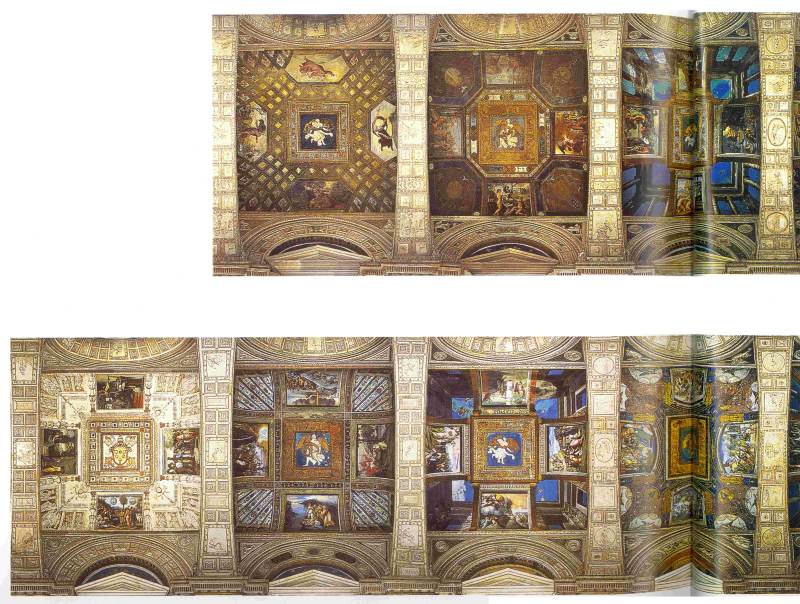 and fig.2.54
and fig.2.54  there are presented all the thirteen vaults of the so called second Loggia of the Sistine Chapel in Vatican known as the ‘Raphael Loggia’. If we look at the central dome images, we shall see that at least six of them depict an angel carrying a bow, see, fig.2.55
there are presented all the thirteen vaults of the so called second Loggia of the Sistine Chapel in Vatican known as the ‘Raphael Loggia’. If we look at the central dome images, we shall see that at least six of them depict an angel carrying a bow, see, fig.2.55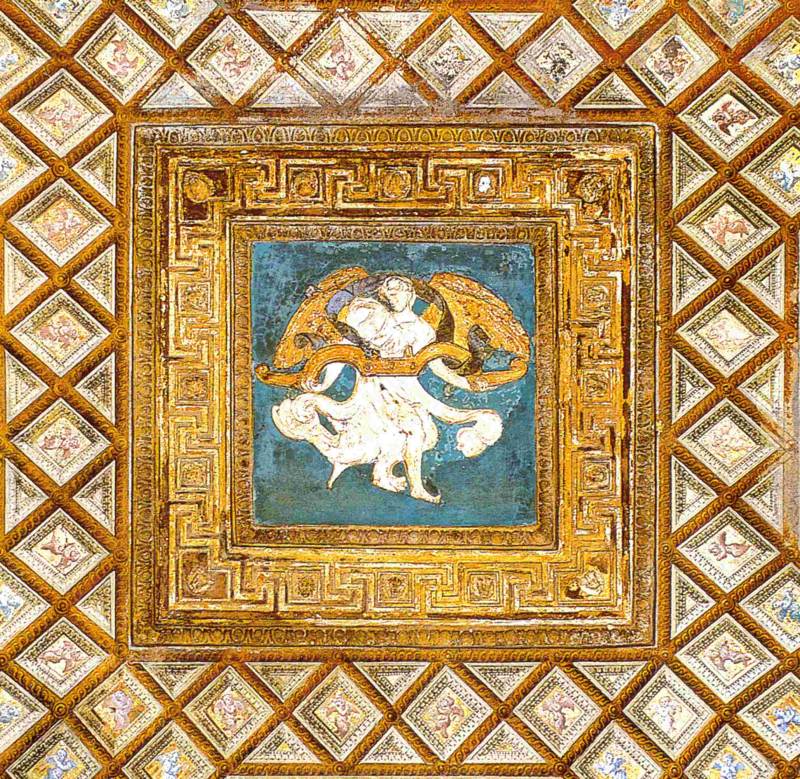 . The other five are the angels with some object resembling a golden royal wreath with three feathers, see fig.2.56
. The other five are the angels with some object resembling a golden royal wreath with three feathers, see fig.2.56 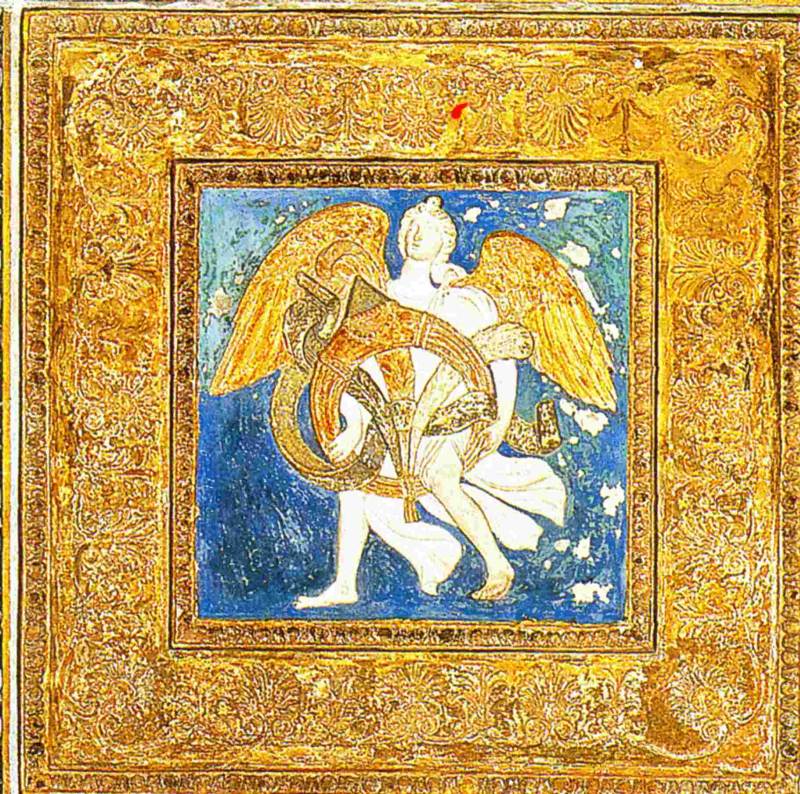 . In another central image we see a coat of arms with two keys of St. Peter the Apostle and a papal tiara on the top, see fig.2.57
. In another central image we see a coat of arms with two keys of St. Peter the Apostle and a papal tiara on the top, see fig.2.57 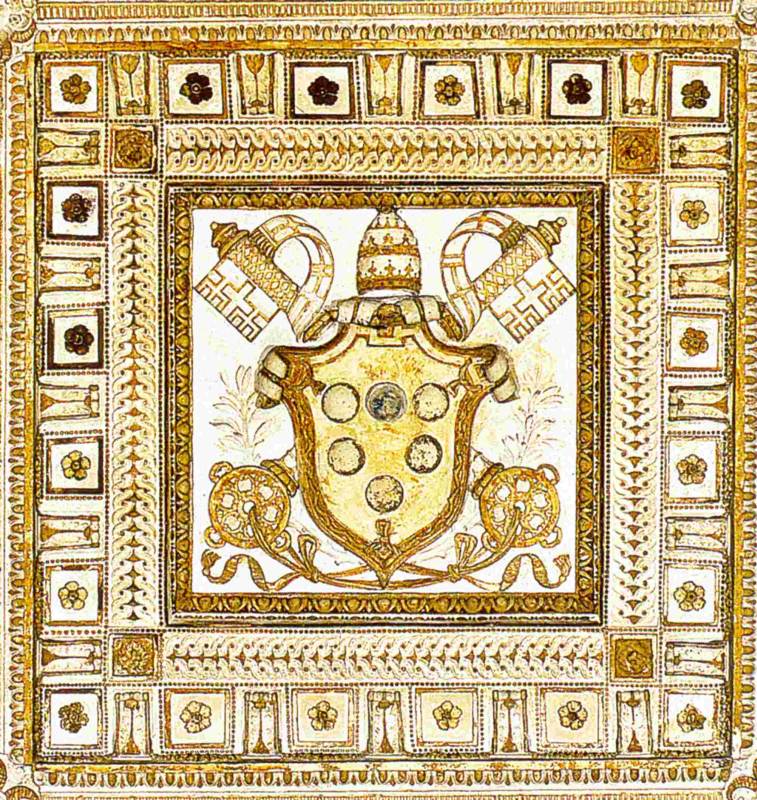 . We could not see one of the images clearly as it fell in the fold of an album [114]. The rest of the images on the ceiling of the Raphael Loggia depict the main events of the Old and New Testaments. In particular, in fig.2.58
. We could not see one of the images clearly as it fell in the fold of an album [114]. The rest of the images on the ceiling of the Raphael Loggia depict the main events of the Old and New Testaments. In particular, in fig.2.58  there is presented a ceiling of the thirteenth vault of the Raphael Loggia in the Sistine Chapel in Vatican. The frescos are called ‘The Scenes from the life of Christ’. We can see here five large paintings – one in the centre and four on both sides. The four side paintings depict the following scenes: the Birth of Christ, the Epiphany of Christ, the Baptism, the Last Supper. I.e. the four major events from the life of Christ. They are all quite usual and fully correspond with the Gospels. But the central image, the main one, is on the contrary, quite unusual. We see here an angel in snow white raiment with golden wings. Right in front of him in his both hands he is holding a huge bow, see fig.2.55
there is presented a ceiling of the thirteenth vault of the Raphael Loggia in the Sistine Chapel in Vatican. The frescos are called ‘The Scenes from the life of Christ’. We can see here five large paintings – one in the centre and four on both sides. The four side paintings depict the following scenes: the Birth of Christ, the Epiphany of Christ, the Baptism, the Last Supper. I.e. the four major events from the life of Christ. They are all quite usual and fully correspond with the Gospels. But the central image, the main one, is on the contrary, quite unusual. We see here an angel in snow white raiment with golden wings. Right in front of him in his both hands he is holding a huge bow, see fig.2.55  . There is no bow-string on the bow (broken?).
. There is no bow-string on the bow (broken?).
We see that according to the ceiling images of the Raphael Loggia the two objects – a bow and a royal wreath - run throughout the entire Sacred history as a common thread. From the common point of view laying such an emphasis on the bow and the wreath as the symbols of the Holy history does not seem clear at all. But from the point of view of the parallel between Christ and the emperor Andronicus Comnenus which we have discovered, it is easy to understand what is going on here. We shall remind you, that according to the Christian teaching Christ existed always and invisibly was present at all the events of the Holy history. That is why the objects associated with Christ could have been depicted not only in the new Gospels’, but also in the Old Gospels’ scenes. This is exactly what we see here.
In regards to the wreath, it is the symbol of imperial power. As Christ – aka Andronicus – was a king, the royal wreath is quite appropriate here. But the most interesting thing presented to us here is a bow. The bow is depicted in particular in the thirteenth vault – one of the two vaults dedicated to Christ. In the centre of the twelfth vault also depicting Christ we see the imperial wreath. It is clear that at least one of the central images of these two vaults should have been dedicated to the Passion, crucifixion or Resurrection. In any case it is obvious that the image should be directly connected with Christ. And not just with Christ, but with a key moment in his life. We see here a huge bow carried by an angel. Incidentally the bow is really quite impressive. Its power is highlighted – not many could bend such a massive military bow.
So, Christ did really have a bow or, at least a bow was in some way closely associated with Christ. It is difficult to interpret this image in any other way. In regards to the Gospels, the military theme is either muted or almost entirely absent.
To conclude we would like to note that the Sistine Capella in the Vatican is not just a normal church. The most famous artists of their time were working on its frescos.
Conspicuous is the fact that the papal coat of arms is depicted in the Raphael Loggia only once, while the BOW AND WREATH – five or six times. It means that they were considered even more sacred as the attributes of the papal power. Such a fact in itself implies their association with Christ.
28.6. THE CENTAURUS AND THE SAGITTARIUS CONSTELLATION.
Let us point out that Andronicus according to Choniates was shooting arrows at the attackers from a bow ‘through the openings in the huge tower which is called Centauri’ [140], p.354. But the word CENTAURI is rather close to the word CENTAURUS. We have already seen many times, that Choniates’ text went through a long process of re-writing and editing. An impression is created from the original text that was written here, that it was Centaurus who was shooting from a bow. For example Centaurus shooting from a bow became a symbol of the Sagittarius constellation. Of course, they might say that the name of the tower from which Andronicus was shooting was accidently implying shooting from a bow. We should not rule it out, however when dealing with the old texts it is necessary to keep in mind that many proper nouns originated as a result of the recent editors not fully understanding the meaning of the old original. That is why if we see a description of a prominent character shooting from a bow from a tower called ‘One Shooting from a Bow’ then most likely the name of the tower is just an extract from an old text not fully comprehended and turned into a ‘name’.
And so what do we have here? Most likely, that the old chronicle, which Choniates was re-writing, said about Andronicus, that ‘Centaurus was shooting from a bow’. The event became so famous that consequently the word ‘Centaurus’ itself became generic. Thus a horseman shooting a bow was hence called this. It is the very same Centaurus-Archer which probably became one of the zodiacal constellations. One of them is called precisely that – Sagittarius (Archer) and is depicted as a Centaurus, see fig.2.59 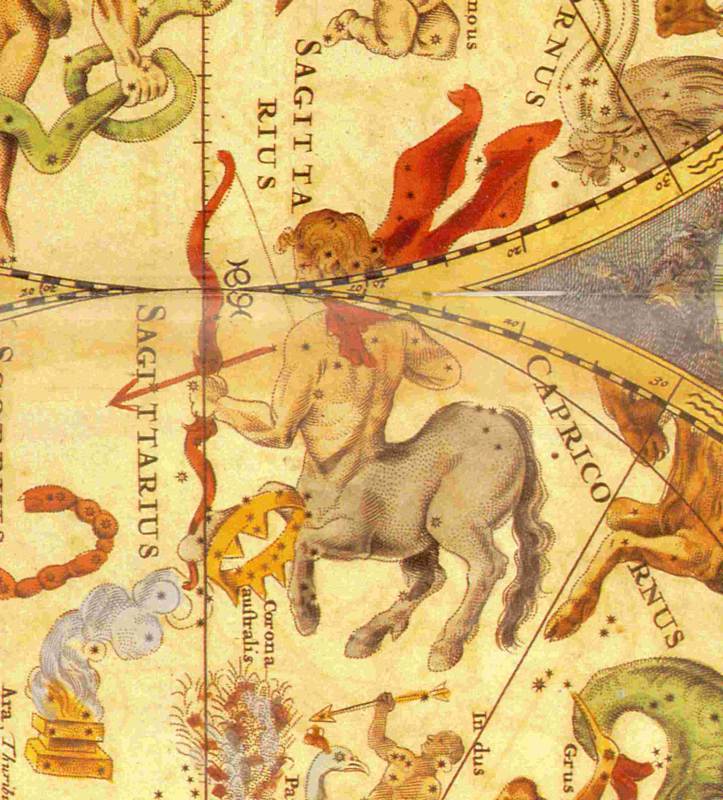 . To remind you the Latin name for the Centaurus Constellation – CENTAURUS. For example this is what the Archer was called in the famous Ptolemy’s Almagest.
. To remind you the Latin name for the Centaurus Constellation – CENTAURUS. For example this is what the Archer was called in the famous Ptolemy’s Almagest.
The suggested picture which we have described unexpectedly finds several dramatic confirmations.
Firstly, the Nativity of Christ is celebrated on the 25th December in the days of the winter solstice. In the XII century on that day the Sun was situated in the Centaurus Constellation. That is why Andronicus-Christ was born under the sign of the Archer, i.e. Sagittarius. Here we need to say that Nicetas Choniates when describing the rule of the Komnenoi and the Angels extensively speaks of the astronomy. The astronomical concepts were widely discussed and great importance was attached to the astrological and astronomical predictions, e.g. [140], p.167.
Our dating of the celestial catalogue Almagest shows that in the epoch of the IX-XII cc. astronomy was starting to be conceived and the stars began to be observed. It was probably then, that the ecliptic was divided into the twelve constellations of the Zodiac known to us now. So there is nothing surprising in the fact that the constellation under which Christ was born was later associated with his name and the corresponding image attributed to him. We know this image as the Archer-Centaurus.
Secondly, the name of CENTAURUS itself, i.e. CEN-TAURUS or KHAN-TAURUS or CZAR-TAURUS also corresponds well with Christ-Andronicus. Let us remember that the star of Bethlehem which heralded his birth flared up in the constellation of Taurus. We have already written that Andronicus was identified with some comet. Therefore Christ-Andronicus in the old chronicles could have easily been called as Czar-Taurus or Khan-Taurus, i.e. Centaurus. To remind you, for the Taurus constellation the word TAURUS is used.
CONCLUSION. The modern depiction of the Sagittarius constellation – a horseman shooting from a bow, could possibly appear as a recollection of Christ-Andronicus shooting from a bow. He was born under the sign of Sagittarius.
It is interesting that at some point Nicetas Choniates directly compares Andronicus to a ‘winged horseman. I.e.: ’Andronicus… getting through a crowd of the best soldiers surrounding him, slipped away from everyone like a WINGED HORSEMAN’ [140], p.151.
Incidentally, bordering to the bow of the Archer (Sagittarius) in the sky is situated the constellation of Northern Crown (Corona Borealis in Latin - Tr.) A bow and a crown are also mentioned together in the Apocalypse: "…and there … was a white horse. Its rider HELD A BOW, AND HE WAS GIVEN A CROWN, and he rode out as a conqueror bent on conquest’ (Apocalypse 6:2). As we talk about it in detail in [МЕТ1] and CHRON1, ch.3 in the Apocalypse there is described a horoscope (discovered by Morozov N.A.) in which a rider with a bow and a crown denotes an Archer. See also our book ‘Kakoi seichas vek?’ (‘What year is it now?’) [ВВЕД]:5.
This explains why on the ceiling of the Raphael Loggia in Vatican several times there are depicted precisely a bow and a wreath. In direct connection with the Holy history and in particular, with Christ.
28.7. THE PLOT OF SATAN – ISAAC ANGELOS AGAINST ANDRONICUS-CHRIST ACCORDING TO THE ANCIENT BOOK OF ENOCH.
Today not many remember the ‘Book of Enoch’, though in its time it was one of the most common Christian texts. ‘Its fate was not a simple one. BEING INCREDIBLY POPULAR IN THE EARLY CENTURIES OF CHRISTIANITY …it was gradually pushed more and more into the shadows… In Russia there was the popular so called (Slavonic – Tr.) Book of Enoch the Righteous … It was copied time and again … the extracts from it were placed in Velikiye Chet’yi-Minei (‘The Great Menaion Reader’, the official Russian Orthodox menologium, a collection of biblical books – Tr.) and in the Russian Orthodox Standard of Righteousness (‘Merilo Pravednoye’ in Russian). It was continually referred to by Metropolitan Macarius and Gennadius the Archbishop of Novgorod. [75], p.6-7. Incidentally the references to the Book of Enoch nevertheless can be found in the New Testament (The Epistle of Jude 1:14)
‘Besides ‘Slavonic Enoch’ and the texts of Enoch presented in the Islamic literature, we also know the Ethiopian version of this book’ [75], p.7. We are going to use the translation of the Ethiopic manuscript of the Book of Enoch published in [75].
This is the description of Satan’s PLOT and his accomplices against God. Two hundred angels decided to descend to Earth and to rule it. ‘Then their leader Samyaza said to them: ‘I fear that you may perhaps be indisposed to the performance of this enterprise and that I alone shall suffer for so grievous a crime’. But they answered him and said: ‘We all swear and bind ourselves by mutual execrations, that we will not change our intention, but execute our projected undertaking’. THEN THEY SWORE ALTOGETHER and all bound themselves by mutual execrations. Their whole number was two hundred, who descended upon Ardis, which is the top of mount Armon… These are the names of their chiefs … Impiety increased; fornication multiplied; and they transgressed and corrupted all their ways… Then Michael and Gabriel … and Uriel, looked down from heaven, and saw the quantity of blood which was shed on earth, and all the iniquity which was done upon it. .. Again the Lord said to Raphael, Bind Azazyel hand and foot; cast him into darkness… To Michael likewise the Lord said, Go and announce his crime to Samyaza, and to the others who are with him… bind them for seventy generations underneath the earth … Immediately after this shall Samyaza burn and perish’’[75], p.16-19.
The Book of Enoch describes Satan’s plot in a very naturalistic way and it does indeed resemble the plot of Isaac Angelos against Andronicus. In fact Isaac Angelos began the entire affair on his own and at first feared that no one will join him and he would have to answer for everything on his own [140]. But he was joined by the other nobles, see above. The plot turned out to be successful. They stripped Andronicus of his power and established their own order. But a few years later as a revenge for Jesus’ death there began a Crusade to Czar-Grad. In 1204 the city was captured and the dynasty of the rebellious Angels-conspirators was destroyed.
Here is a rather curious image of Christ’s crucifixion, see fig.2.60 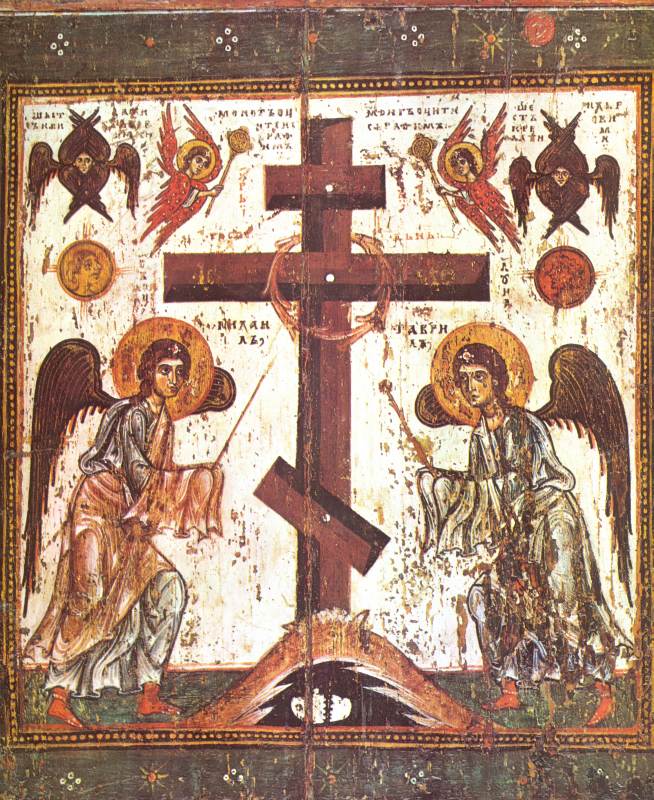 . It is painted on the reverse of the famous Novgorod icon ‘The Saviour Not Made By Hands’. On it there is depicted the cross on which Christ was crucified. Next to the cross there is a sign: ‘The Holy Cross’. From the two sides the two winged angels are approaching the cross, one holding a spear and the other – a sponge. They hold them in such a way as if one trying to pierce the body side of Jesus hanging on the cross and the other one is going to put the sponge to Christ’s mouth. Such old imagery is widely prevalent, see for example fig.2.61
. It is painted on the reverse of the famous Novgorod icon ‘The Saviour Not Made By Hands’. On it there is depicted the cross on which Christ was crucified. Next to the cross there is a sign: ‘The Holy Cross’. From the two sides the two winged angels are approaching the cross, one holding a spear and the other – a sponge. They hold them in such a way as if one trying to pierce the body side of Jesus hanging on the cross and the other one is going to put the sponge to Christ’s mouth. Such old imagery is widely prevalent, see for example fig.2.61 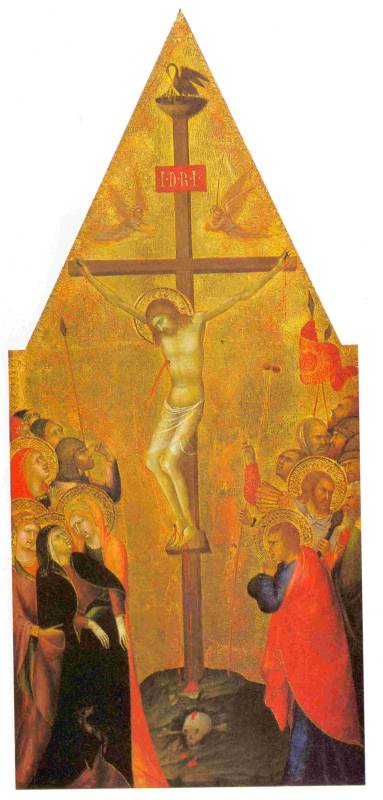 , fig.2.62
, fig.2.62 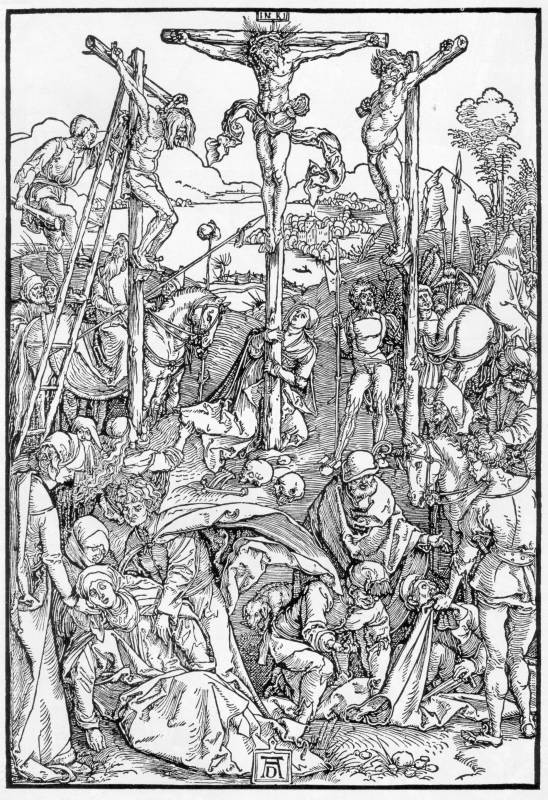 and fig.2.63
and fig.2.63 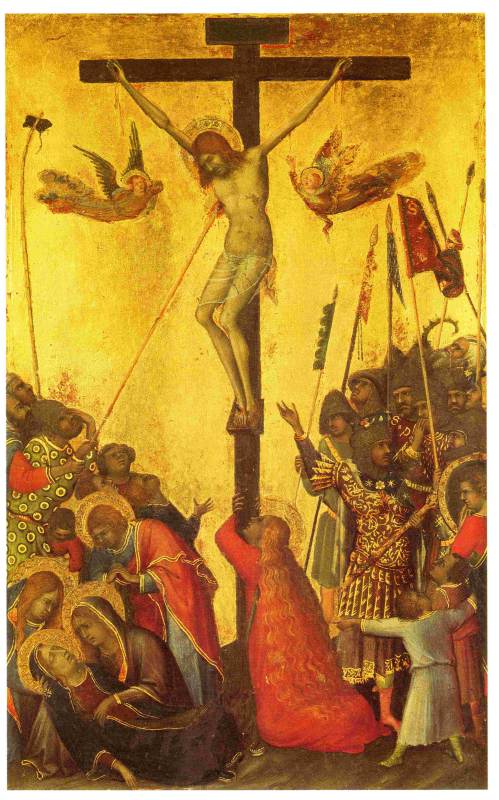 . BUT THE SPEAR AND THE SPONGE ARE ALWAYS HELD BY THE SOLDIERS CRUCIFYING CHRIST, BUT NOT AT ALL THE ANGELS. Which means that the spear and the sponge are always in the hands of Jesus’ enemies. They are the execution tools. But on the Novgorod icon they are in the hands of the angels! Where the angels here take the place of the Roman soldiers next to Jesus’ cross, see fig.2.60
. BUT THE SPEAR AND THE SPONGE ARE ALWAYS HELD BY THE SOLDIERS CRUCIFYING CHRIST, BUT NOT AT ALL THE ANGELS. Which means that the spear and the sponge are always in the hands of Jesus’ enemies. They are the execution tools. But on the Novgorod icon they are in the hands of the angels! Where the angels here take the place of the Roman soldiers next to Jesus’ cross, see fig.2.60  .
.
A completely analogous plot was also depicted by the Western European mediaeval painters, see fig.2.64 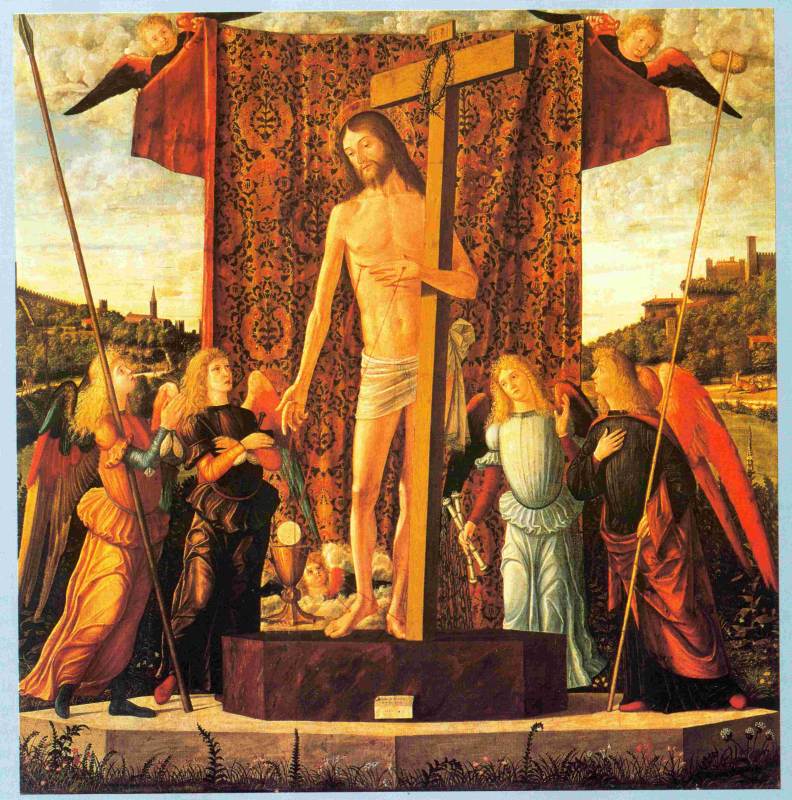 . Here next to the cross there are standing four angels and two of them are holding the execution tools – a spear and a sponge, while occupying the same positions as the Roman soldiers in the other paintings.
. Here next to the cross there are standing four angels and two of them are holding the execution tools – a spear and a sponge, while occupying the same positions as the Roman soldiers in the other paintings.
It is of course possible to interpret these images in different ways. However, as we understand it now, here survived a clear trace of the true events of the XII century, when Andronicus-Christ was in fact betrayed by the Angels, who at first served him, but then later betrayed him. And the rebellion was led by Isaac Angelos.
28.8. ISAAC ANGELOS SETS UP ‘CHRIST’S CRUCIFIX’ IN CZAR-GRAD.
In the very beginning of Isaac Angelos’ reign Niketas Choniates reports the following interesting detail. ‘The king’s wish TO MOVE ‘The Crucifixion of Christ’ a work of art breath-taking in its artistry and fineness (another version of this text: ‘presenting His sufferings with a remarkable detail’ – Author) FROM Monemvasia to the same place (i.e. to the temple which was being erected in Czar Grad – Author), reached an extraordinary level of intensity. He was entirely consumed by his anxiety until in the end he succeeded in cunningly stealing it, as a publicly attack at the very least could have been dangerous’ [141], p.97.
It is possible that this place could be an obscured narrative about Isaac Angelos’ erection of a cross in Czar-Grad for the crucifixion of Andronicus-Christ. This became possible only after the success of the revolt against Andronicus, i.e. after some ‘rather dangerous assault’. It is most likely that the old source was describing Christ’s crucifixion itself. But the later editor under the influence of the scaligerian version of history replaced the crucifixion, i.e. the deed itself, with allegedly some depiction of it, ‘presenting Our Saviour’s sufferings with a remarkable accuracy’. They created an allegory. The exact meaning of the original was erased, which was the aim.
Nevertheless, the story of Christ’s crucifixion during the reign of Isaac Angelos still remained, though in a half-erased, blurred way.